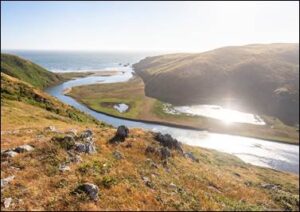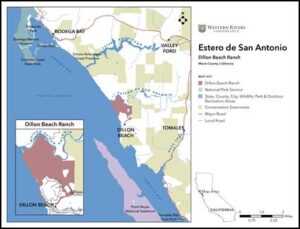
DILLON BEACH, Marin County, Calif. (September 14, 2024) — Western Rivers Conservancy (WRC) has conveyed the 466-acre Dillon Beach Ranch to the Federated Indians of Graton Rancheria (Graton Rancheria) for permanent conservation and stewardship. Graton Rancheria is a sovereign nation and a federally recognized Tribe with its aboriginal territory in Sonoma and Marin Counties. The Tribe, comprised of Coast Miwok and Southern Pomo Indians, is the only federally recognized Tribe culturally and traditionally affiliated with Marin County. With this land-back ownership transfer, Graton Rancheria regains stewardship of lands within the Tribe’s aboriginal territory. These conservation lands include 1.5 miles along the Estero de San Antonio and 1.5 miles of Pacific coastline. The estuary and surrounding grassy terraces provide vital habitat for a host of native fish, animal and plant species.
“Regaining full ownership and stewardship of Dillon Beach Ranch represents an opportunity for us to reconnect with our ancestral lands and preserve a very important place for future generations,” said Federated Indians of Graton Rancheria Tribal Chairman Greg Sarris. “This area and surrounding lands are within the ancestral homelands of the Coast Miwok, and our descendants are still present there today. We look forward to working closely with Western Rivers Conservancy and state partners to craft a durable management plan that forever preserves and protects Dillon Beach Ranch, the Estero de San Antonio and the irreplaceable cultural and natural resources they harbor.”
“With the incredible array of wildlife found in and around this small estuary, Dillon Beach Ranch is truly a jewel of the Northern California Coast,” said Nelson Mathews, WRC’s interim president. “We are deeply proud to partner with the Federated Indians of Graton Rancheria so they can own and manage these ancestral lands to preserve the ranch’s invaluable cultural and natural resources.”
The Environmental Riches of Dillon Beach Ranch
The Estero de San Antonio is formed by Stemple Creek and provides important habitat for a vast array of fish, birds, insects, plants and animals, including the federally listed northern tidewater goby.
Dillon Beach Ranch is approximately 40 miles north of San Francisco’s Golden Gate Bridge and boasts rolling green headlands, expansive views of Bodega Bay and a sloping beach. Most of the ranch is coastal terrace surrounded by steep bluffs leading down to the estuary and ocean. Mule deer graze the terraces, and the grasslands provide habitat for Myrtle’s silverspot, an endangered medium-sized butterfly. The ephemeral streams feeding the estuary offer excellent habitat for the threatened California red-legged frog. Near the mouth of the estuary, the ranch provides a commanding view of the coast from more than 400 feet above the sea. The property was operated for decades as a cattle ranch and was purchased in 1999 by Saint Antony Monastery, which sold the property to Western Rivers Conservancy in December 2023. The Tribe plans to allow grazing on the property and introduce Traditional Ecological Knowledge to protect the ranch’s natural resources and reduce wildfire risk to the area.
 Dillon Beach Ranch is adjacent to the Estero de San Antonio State Marine Recreation Management Area, which the California Department of Fish and Wildlife (CDFW) manages and established for the benefit of the unique and imperiled fish and wildlife in this area – a testament to the importance of the estuary and its surrounding habitat. WRC purchased the ranch using a Program Related Investment from the Gordon and Betty Moore Foundation and then worked with Graton Rancheria to secure funding from CDFW that allowed the Tribe to acquire the property. The Kelly Foundation and individual donors provided support to WRC for costs that were critical to the project.
Dillon Beach Ranch is adjacent to the Estero de San Antonio State Marine Recreation Management Area, which the California Department of Fish and Wildlife (CDFW) manages and established for the benefit of the unique and imperiled fish and wildlife in this area – a testament to the importance of the estuary and its surrounding habitat. WRC purchased the ranch using a Program Related Investment from the Gordon and Betty Moore Foundation and then worked with Graton Rancheria to secure funding from CDFW that allowed the Tribe to acquire the property. The Kelly Foundation and individual donors provided support to WRC for costs that were critical to the project.
“Permanently protecting Dillon Beach Ranch, and the southern banks of the Estero de San Antonio specifically, benefits everyone in California,” said Charlton H. Bonham, director of CDFW. “Creating pathways to Indigenous land management in the state of California is a central commitment of our department. We are pleased to partner with Western Rivers Conservancy to return this culturally and environmentally significant property to its original steward, the Federated Indians of Graton Rancheria.”
“Dillon Beach Ranch is a spectacular property,” added Dan Winterson, who manages the conservation portfolio at the Gordon and Betty Moore Foundation. “This is a great win for conservation in Marin and the whole Bay Area. WRC did an amazing job of seeing this complex transaction through to completion.”
Western Rivers Conservancy – A Leader in Land Back
For more than 30 years, WRC has taken the lead in marrying conservation and Tribal land back outcomes, working with Tribal nations around the West to permanently protect rivers and the lands that sustain them. WRC and its many tribal partners, who are the original stewards of riverlands across the West, make natural conservation partners, given tribal nations often possess the resources, foresight, expertise and commitment to restore and conserve these vital places in perpetuity. A complete list and history of WRC’s Tribal nation partnerships are available here.
Federated Indians of Graton Rancheria – A Deep Commitment to Conservation of Lands and Cultural History
Graton Rancheria’s mission of social justice and environmental stewardship is exemplified by its efforts to preserve lands within its aboriginal territory and provide continued protection of natural resources. Graton Rancheria currently co-manages Point Reyes National Seashore with the National Parks Service, a first-of-its-kind partnership between a Native American tribe and the NPS. Additionally, the tribe co-manages Tolay Lake Regional Park in Sonoma County.
